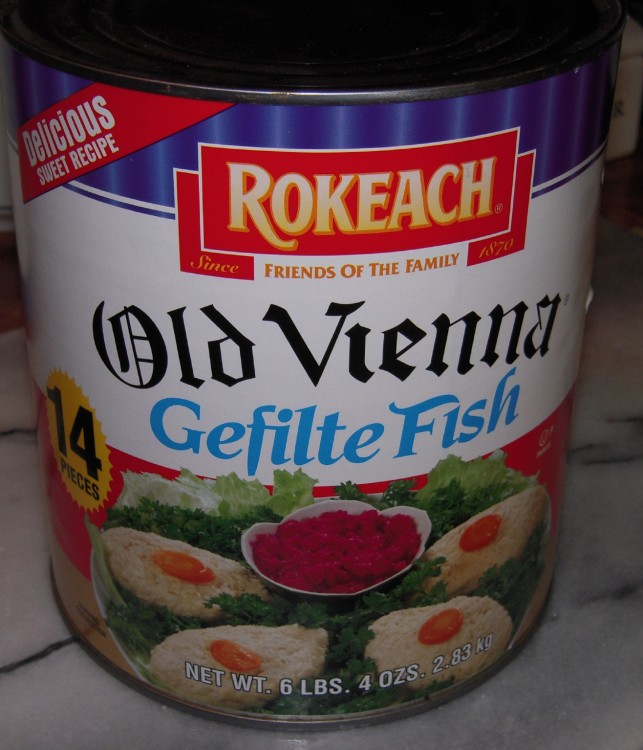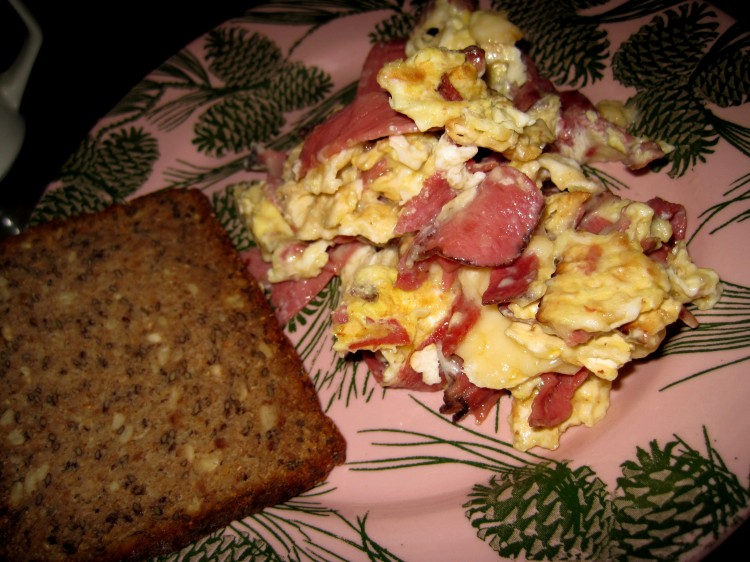
Each year I try to purchase a few things that Steve, my husband, would have been eating during certain holidays as a kid. Since I’m from the same place and have been eating most of that stuff my whole life, I’m happy to do it.
Note that the idea here is to have some traditional Jewish foods available. I’m not doing anything “official” or Kosher.
Like a broken record, let me again mention Costco.
I know Purim and Passover are around the corner when those #10 cans of Rokeach* gefilte fish show up there. The canned version may not the best, but it’s OK, and $7.99 for 14 pieces is nothing to kick out of bed. While “gefilte fish” literally means “filled fish,” nowadays they are large, poached fish balls made from whitefish or pike, matzoh meal and onions. Years ago, the fish mixture was stuffed into a fish skin before poaching whole. This allowed people of limited means to enjoy a whole fish on the Sabbath, even if it was stretched with filler. Gefilte fish is good chilled with a little horseradish, and I always buy an extra can to have on hand to serve during the summer.
Costco had Rokeach hamentashen, too, but they contained high fructose corn syrup, so I passed. Hamentashen are pastries made with short dough that’s partially folded over fruit filling, and they can be great if made at home or by a neighborhood bakery.
The Richmond, CA, Costco is good for smoked salmon, both farmed and mild, and, wonder of wonders!, whole smoked whitefish from the Acme Smoked Fish Corporation in Brooklyn, NY. These fish are sold tail, head and all, in shrink wrap, for $6.99 a pound. This is an incredible bargain, and I’d buy a Costco membership just to keep us flush with reasonably-priced smoked whitefish. They used to carry Acme’s whitefish salad at $7.99 for a two-pound tub, but, alas, I have not seen it for over a year. Maybe the nice Costco blog spies will pass along my request to bring the whitefish salad back to Richmond.
Smoked whitefish is salty and rich, and you can mix the flesh with a little good mayo and serve it on bagels. Alternatively, cut the whole fish into sections and eat it just like that with rye bread. Serve the smoked salmon (lox) with some sliced cucumbers, red onion and sour cream on the side if you want to go the non-bagel route.
I like to buy chocolate covered jelly rings and candied fruit slices, too. I have yet to find these anywhere other than Saul’s Restaurant & Delicatessen (1475 Shattuck Avenue, Berkeley), a place I don’t like to go . I find them significantly overpriced – to the point of being laughable. Their whitefish salad has celery and costs $15.75 a pound, and the sandwiches are skimpy for the price. Whole smoked whitefish is $18.00 a pound – which is insane. This is what happens when there’s no competition. While I prefer to give my business to a local place, moral indignation prevents me from doing so here.
I always have high hopes for Cost Plus World Market in terms of the jelly rings and fruit slices, but no luck so far. (That reminds me to get over there to buy what I can of the Cadbury chocolate before Kraft is involved in its production!)
There is no reason to buy cooked brisket, another popular food item this time of year. Brisket is a primal cut of beef from the forequarter just below the chuck. Many supermarkets have trimmed, whole briskets shrink-wrapped, and they run about 7 pounds. Make sure you get one with the fat cap intact. A good place to purchase brisket in the SF Bay Area is Smart & Final. A long, boneless, flat, tough cut, it needs to be cooked for some time, after which it’ll be tender and flavorful. Just rub with Kosher salt and pepper and roast (at a low temperature) or braise with aromatics and then slice against the grain after resting. If you roast it, add some liquid to the pan and replenish it as it evaporates. Whatever your method, place it in your pan fat side up so the fat can run through and tenderize the meat during the cooking process. Serve with potatoes or slice and pile high on good rye bread while warm. Provide good mustard and horseradish.
I also make a small batch of chopped chicken liver, which Steve loves, having childhood memories of chopping the livers with a mezzaluna for his mother. There are a million recipes for this on the Web, but the lowdown is that you’ll need rendered chicken fat for any reputable recipe. This is why I tell you to freeze the bits of chicken fat you trim from whole chickens and thighs. See my previous post about the chicken fat. You’ll need chicken livers, of course, which should be trimmed of connective tissue, which feels like string; use kitchen shears or a paring knife against a cutting board. Also, some finely chopped onion, hard-boiled egg that has been chopped, and salt and pepper. This is bare-bones but very good, and I’ll give you the process, if not a full recipe:
Saute the livers in some rendered chicken fat until just done and set aside. Do not overcook them! Saute the onions in the same pan. Chop the livers. Put chopped livers, egg, onion, salt and pepper in a bowl and mix with enough extra hot rendered chicken fat to wind up with a moist spread. Your ratio will be something like 1/2 cup of rendered chicken fat to each pound and a quarter of livers. One egg and a very small yellow onion will be fine if you make the base quantity of livers. Feel free to process the mass, but no need, really, unless you want it smooth.
I promise to make my own gefilte fish next year, so if you have a good recipe, please email it to me.
*In case you didn’t know this, Manischewitz owns numerous brands, including Rokeach, Mother’s, Goodman’s and Mrs. Adler’s, so these names don’t mean what they used to.




